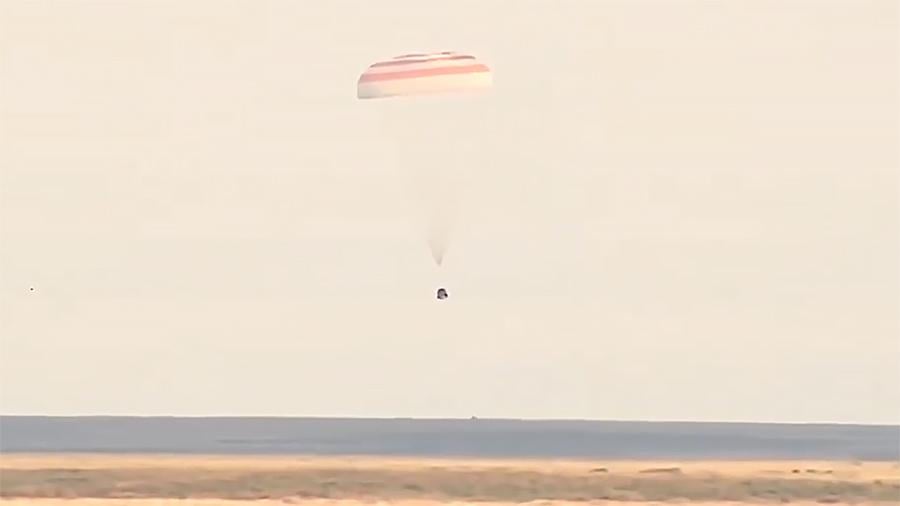
HOUSTON -- Russia's Soyuz MS-26 spacecraft with NASA astronaut Don Pettit and cosmonauts Alexey Ovchinin and Ivan Vagner departed the International Space Station (ISS) for a parachute assisted landing and recovery in remote Kazakhstan to conclude the latest crew exchange aboard the seven person orbital lab.
The descent module touched down southeast of Dzhezkazgan, Kazakhstan at 9:20 p.m., EDT, or April 20 at 6:20 a.m.an hour after sunrise in Kazakhstan, following its departure from the Earth facing ISS's Russian segment Rassvet module docking port at 5:57 p.m., EDT. The landing was setup by a 4 minute, 41 second deorbit burn 8:27 p.m., EDT, followed by separation of the Soyuz orbital, instrument and propulsion segments from the descent module with the crew.
"Everything is fine. The crew is feeling fine," Ovchinin informed Russian flight controllers with translation during the final minutes of the atmospheric descent.
The descent module was met within minutes of landing by Russian led recovery teams aboard helicopters and land rovers to assist the trio from the Soyuz capsule and provide initial medical checks. They returnees were to be flown by helicopter to Karaganda in Kazakhstan where Pettit was to board a NASA aircraft for flight to NASA's Johnson Space Center in Houston. Ovchinin and Vagner were to be flown to Star City, Russia, just outside of Moscow.
The return concluded a 220 day mission that began with the Sept. 11, 2024 launch of the Soyuz MS-26 with Petitt, Ovchinin and Vagner from the Baikonur Cosmodrome in Kazakhstan.
The landing fell on Pettit's 70th birthday. A chemical engineer, Pettit is NASA's oldest active astronaut and his now completed four spaceflight missions to log a total of 590 days in space. Ovchinin completed his fourth spaceflight and has now accumulated a total of 595 days in space. The mission was Vagner's second to space, spanning a total of 416 days.
With the undocking of the MS-26 command of the ISS formally transitioned from Ovchinin to Japan Aerospace Exploration Agency astronaut Takuya Onishi for the ISS Expedition 73 now underway.
"We will continue to do our best just like you guys did," Onishi told Ovchinin during a traditional April 18 change of command ceremony aboard the ISS.
The Expedition 72/73 crew exchange began with the Mar. 14/15 launch and docking of NASA's Crew-10 Dragon with NASA astronauts Anne McClain and Nicole Ayers, Onishi and cosmonaut Kirill Peskov to begin a six month stay. Their arrival was followed on Mar. 18 by the return to Earth of NASA's Crew-9 Expedition 72 foursome of NASA astronauts Nick Hague, Barry "Butch" Wilmore and Sunita "Suni" Williams and cosmonaut Alexsandr Gorbunov.
Hague and Gorbunov had launched aboard their Crew-9 Dragon on Sept. 28, 2024 with two empty seats to enable the return of Wilmore and Williams, who had served an extended mission after launching on June 5, 2024 as the commander and pilot of NASA's Boeing CST-100 Starliner Crew Flight Test.
Post-launch, the Starliner experienced propulsion system issues that were managed in order for Wilmore and Williams to dock Starliner with the ISS. Out of safety concerns, NASA decided to deorbit Starliner without Wilmore and Williams in early September.
NASA's crew exchange activities were followed by the April 8 launch and docking of the Soyuz MS-27 with cosmonauts Sergey Ryzhikov and Alexey Zubritsky and NASA astronaut Jonny Kim for an anticipated eight month stay.
With the ISS Expedition 72/73 crew exchange now complete, the seven member Expedition 73 crew of three NASA astronauts, three cosmonauts and one Japanese astronaut are awaiting the launch of SpaceX's 32nd NASA contracted Dragon resupply mission planned from the Kennedy Space Center on April 21 at 4:15 a.m., EDT.
Docking to the ISS is planned for April 22 at 8:20 a.m., EDT, for the delivery of a 6,700 pound cargo of crew supplies, scientific research and technology development equipment, and station hardware.





